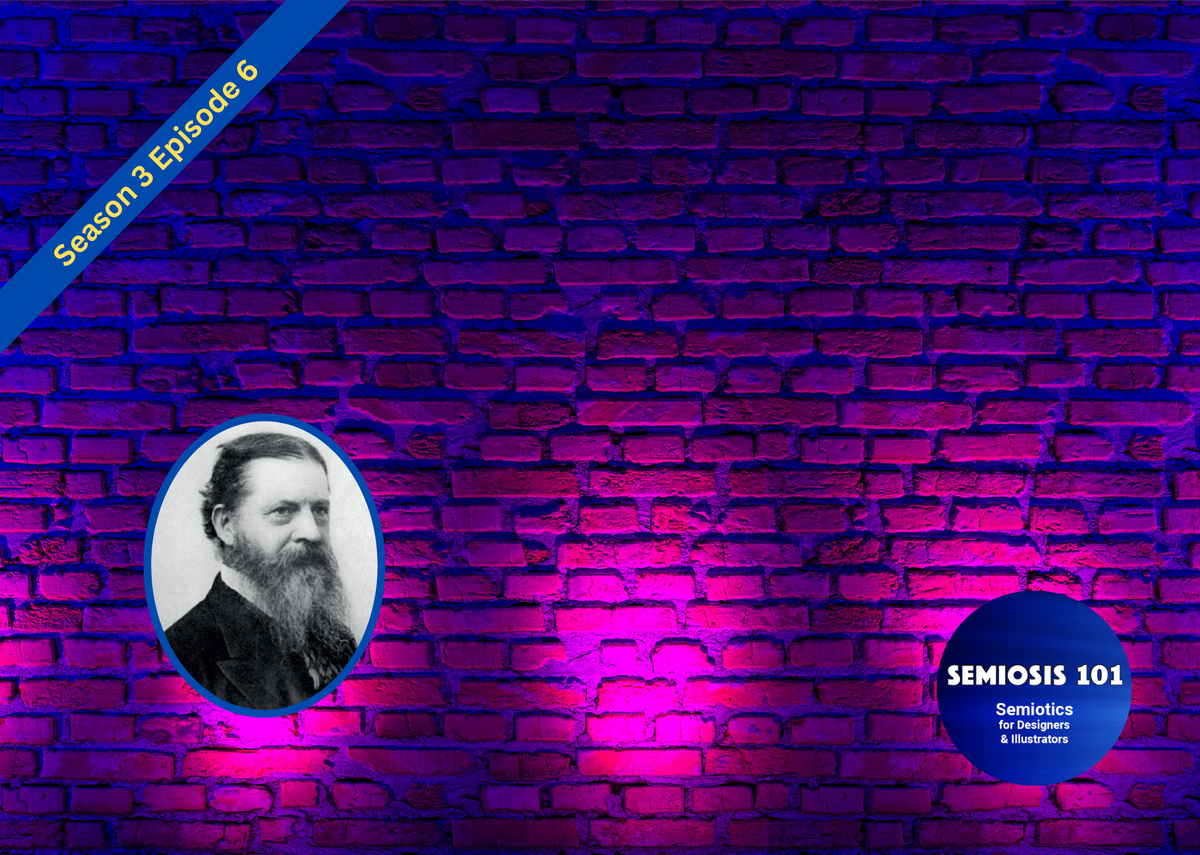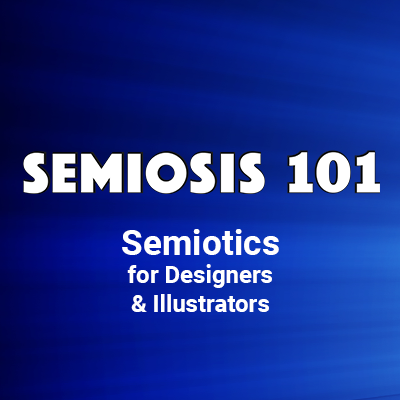Free Semiosis 101 Transcript 3.6:

BLOCKING IN MEANING: Encoding Semiotic Visual Communication
Hello readers.
In this free transcript for the episode published on Semiosis 101 on Weds 29 November 2023, we will focus on building more complex visual messaging and why Peirce runs three separate terms together to describe a semiotic sign class.
Watch the free episode on YouTube for the full impact…
…and here is the episode’s transcript.
Semiotically speaking, we are discussing semiotic signs. Plural. A single semiotic sign is actually not a single sign. Ok, let me explain. Last week we began to frame the lowest sign classification Peirce defined, as part of ten classes of sign. A Qualisign that utilises Iconic representation to Rhematically propose a quality as a semiotic sign of something else. This is the lowest form of encoding meaning as a colour, a line, shape, etc. It is ephemeral and needs the audience to perceive it as a semiotic sign for another thing.
But it remains the lowest perceptible meaning-bearing type of sign. What of the next, more powerful forms? Hit subscribe to this YouTube channel, and I will explain…
Later in this season we will examine Peirce’s ten sign classifications, from simple to complex. Before we are at that stage of understanding, we need to explain the underpinning of the theory to get you to that level of understanding. The official terminology Peirce employs to describe the lowest class of semiotic sign is a Rhematic Iconic Qualisign.
“What now?”
A Rhematic Iconic Qualisign. This is sign one in a class of ten signs, ascending in complexity from this first sign.
A Rhematic Iconic Qualisign.
“Will you please just stop repeating those words!”
What? You want me to stop calling Sign One, which Peirce calls a Rhematic Iconic Qualisign, a Rhematic Iconic Qualisign?
“YES! It is just word salad!”
What? A Rhematic Iconic Qualisign is a word salad?
“YESSS!!! Stop it!”
I think you viewers (and semioticians) are getting the picture. Peirce’s terminology may be accurate in the context of his theory, but it is problematic to the lay person. It is just too obtuse. So, let Semiosis 101 help. In this episode we will focus on, not the complexity of terminology, but building more complex visual messaging.
So let me quickly give you a quick and easy understanding of why Peirce runs three separate terms together.
concept > representation > interpretation > concept > etc.
Semiosis - semiotic sign-action - is not linear but cyclic. An idea needs visually communicating - concept. (Peirce’s Object). That idea is visualised - representation. (Peirce’s Representamen). That visualised idea is decoded by the target audience - interpretation. (Peirce’s Interpretant). The idea put in the mind of the audience of what the visual means, should be a facet of the idea we started with. I say facet rather than the full concept intentionally. The visual representation of the concept begins at the lowest semiotic sign-action power of qualities, possibilities, familiarities and resemblances.
This needs to have an effect on the perception of the audience to Interpret a quality as a semiotic sign of something else. This lowest level is only semiotically powerful enough to trigger perception of being meaning-bearing. That meaning is basic and weak without further support from more complex semiotic encoding. I keep referring back to a brick and architecture. A brick can become any building. But it needs other bricks to become something more. A municipal building in the heart of any city contains many bricks. It cannot be a municipal building without single bricks. Builders do not begin building the municipal building without foundations.
We can think of the lowest class of semiotic sign as a single brick. It has potential to contribute to building and communicating more complex meaning, just as a brick can contribute to a grand building. Just like the brick cannot be seen yet as the full building, a simple semiotic sign cannot be expected to convey the full meaning of the concept through its representation. It can only contribute toward that full meaning by helping to trigger interpretation in the audience.
The full concept can only fully be conveyed in the minds of the target audience interpreting what they see, by nesting many lower level semiotic signs together to build more complex meaning. The semiotic power within any of the ten classes of sign is built on nesting lower level signs together, like Russian Babushka wooden dolls.
Just as a course of bricks cemented together can become load-bearing, enabling more complex building to be built, semiotic sign classes’ power to be meaning-bearing relies on its own binding medium. In the three-word salad of a name which Peirce utilises to describe each of the ten sign classes, the power I have discussed is there in plain sight.
The first word describes … the perception power of the sign.
The second word describes… how the meaning is communicated.
The third word describes… the type of “vehicle” that the sign uses to carry the meaning.
This is beginning to sound like a game of Top Trumps for semiotic sign-action!
The first word explains, in Peircean theoretical terms, the power the sign has to convey meaning to the audience. The second the power of semiotic representation used, and the third how the audience receives it. Let us put that into a designer-centric context.
The first part of a class of semiotic sign can either be: possibly suggesting (Rhematic), or proposing (Dicent), or employing an agreed understanding (Argument) that the perceived meaning is what the audience perceives it as. A semiotic sign (A) is either possibly suggesting its (X), or proposing it IS (X), or employing established visual language that (A) is agreed to mean (X) in this context of use.
The semiotic sign utilises three levels of representation of the concept to be visually communicated. In our example, the second word relates to whether (X) is semiotic encoded in (A) using Iconic, Indexical or Symbolic representation. The semiotic sign may visualise (A) to mean (X) by using lines, shapes, marks, colours, etc. to suggest familiarity (Iconic) to aspects of (X)’s qualities. The second word, at higher semiotic sign-action levels, could use representation to have more of a direct connection (Indexical) to (X), or a socio-cultural agreement that when the audience sees (A) they understand it does mean (X) in this context (Symbolic). The final word in the three-word salad explains the “sign-vehicle” used to convey the meaning.
The lowest “sign-vehicle” we have so far explored is a Qualisign. As a sign-vehicle, a Qualisign is ephemeral. It is on the edge of perception. Once the audience perceives meaning-bearing, the Qualisign semiotically …evaporates. It has done its job. It is a phenomenological moment on the edge of perception, but without it semiotic signs would remain dormant. Think of a Qualisign not as a tangible designed thing, but as a moment the audience begins to perceive the visual as meaning-bearing.
The third word, at higher semiotic sign-action levels, delivers the semiotic sign either as a single-use sign in the form of a Sinsign (sin as in single and not naughty!), or as a Legisign. These terms need more time to unpack so I will return to these in future episodes. So, now we have context to Peirce’s word-salad. In designer-centric terms, each of his ten classes of signs draws its power from an interplay between:
1) the perception power of the sign,
2) how the meaning is communicated, and
3) the type of sign-vehicle that the sign uses to carry the meaning.
Perception | Encoding | Delivery.
So, let us try again, eh?
Rhematic | Iconic | Qualisign
possible | familiar | instant
Any better?
We can say that the first step to encoding semiotic signs is to trigger perception. By utilising Iconic representation to visualise possible familiar qualities the target audience will perceive, this subconscious triggering is instantaneous …if perceived. A moment before the audience had no perception of possible meaning. Now they subconsciously interpret a possible meaning, which kickstarts the audience’s further interpretations. A small quality, with other qualities begin to build more and complex meaning. These visual qualities have subconsciously moved the interpreter from no perception… to perception …from what they see visualised.
That instance of perceptual movement is where the Qualisign acts as a sign-vehicle for the audience. It triggers perception and then is no longer important. The visualised quality is in plain sight. It is semiotically dormant until perceived as meaning bearing. Designers and illustrators already employ this visual trick in their work. You do not believe me?
Consider the arrow hidden within the FedEx logo. First you do not see the arrow. Then you see it. It is and is not there. The negative space that forms the letters of FedEx also provide the quality of an arrow shape. The moment of perceiving the arrow, the audience moves from one state to the other. In illustration too this technique has been employed for millennia. Consider example of Joey Guidone’s Pirate where the illustrator has used the tricorn hat to suggest the noose.
In these examples, I am not saying to you that these COMPLETED designs or illustrations are a “Qualisign.” So, please do not get distracted. We are focusing on the MOMENT of when YOU PERCEIVE a quality as meaning-bearing. Come back next week, when we will semiotically cement these semiotic blocks of meaning into more solid examples.
Semiosis 101 Semiotic Design Resources is a reader-supported publication. To receive exclusive posts and support my work, consider becoming a free or paid subscriber. Paid subscribers get name checked on all future Semiosis 101 YouTube episodes.
===Semiosis 101 Patreon Producer==============
Become a Semiosis 101 Patreon Producer and get a named producer credit on future video episodes, plus watch all new episodes months ahead of YouTube.
===Semiosis 101 Patreon Exclusives==============
Watch longer Patreon-exclusive Semiosis 101 episodes on applying Semiosis into design and illustration…
PATEXC001 How does semiotics work in illustration?





